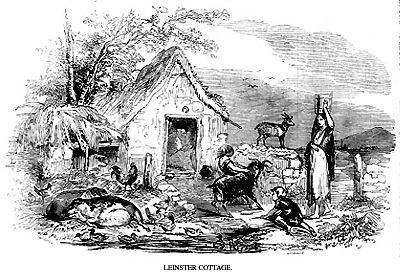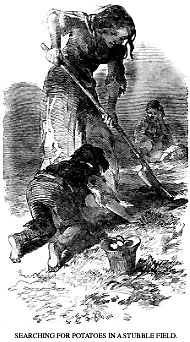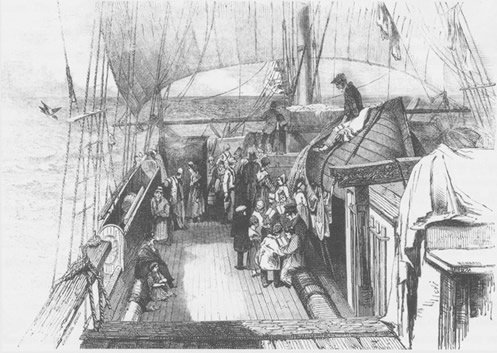Farewell to Erin:
What Motivated the Exodus?
Mary Kilfoil McDevitt
Archivist, Diocese of Saint John
Contrary to popular tradition, the flow of emigrants from Ireland to New Brunswick did not begin with the Famine of the mid 1840s. The trickle of immigrants that began arriving in the early years of the nineteenth century quickly accelerated to a steady stream throughout the 1820s, 30s and early 40s – a fact that has come to be obscured by the inundation that followed in the last few years of the latter decade. As overwhelming and unprecedented as this Famine migration was, most of these immigrants were merely “passing through” on their way to Boston, New York, Philadelphia or Upper Canada. Despite a significant increase in the proportion of Irish-born in New Brunswick as a result of the Famine immigration, the pre-Famine Irish continued to constitute a larger proportion of the resident Irish population of the province, which begs the question, why did they leave Ireland?

The Great Famine of the 1840s was a tragedy of such scope and magnitude that the era which preceded it is often perceived as having been somewhat idyllic by comparison: post-card images of a poor but proud peasantry, tending their fields and spinning their flax, a simple but essentially satisfying existence. In reality, Ireland on the eve of the Famine was a nation reeling under the weight of a stagnating economy, burgeoning unemployment, successive crop failures and a staggering yearly population increase.
Though still economically and agriculturally backward in relation to the rest of Western Europe, Ireland at the turn of the 19th century was experiencing the social turmoil and economic upheaval associated with the forces of what various historians have termed the “commercialization” of Ireland. Her economy had become so intimately tied to that of Britain that it was easy prey to fluctuating prices and market conditions. As far as England was concerned, Ireland was merely a supplier of foodstuffs and raw materials. When cheap English manufactured goods began to flood the Irish market, Irish industry could not compete. Domestic industry in Ireland virtually collapsed, and thousands of craftsmen, particularly textile workers, were reduced to beggary and starvation in many areas. For countless Irish households, the demise of the cottage industry meant no way to pay the rent. The end of the tariff protection for Irish textiles and crafts in the 1820s dealt the artesian class a further blow. Practically overnight, countless artisans had joined the ranks of the unemployed.
Rural workers were just as hard hit. With the commercialization of agriculture came consolidation of small farmlands, labour-saving techniques, and evictions. The return to pastoral agriculture meant farming became much less labour-intensive, and hordes of rural laborers became superfluous. By this time, farms had become so small as a result of subdividing that farmers could barely sustain a subsistence livelihood, much less provide land for their sons. Generally speaking, areas with the smallest farm holdings also had the poorest soil.

By the early years of the nineteenth century, unemployment in Ireland had reached alarming proportions. Woodham-Smith claims that by 1835 three-quarters of all Irish labourers existed without regular employment. To compound the problem, Ireland was so “under-industrialized” and “under-urbanized” that her cities could not absorb the excess labour. Outside of Belfast and Dublin, there simply were no large, industrialized cities in Ireland, and in any case, unemployment in the cities was as much a problem as unemployment in the countryside. In fact, while most western European cities were swelling with in-coming rural unemployed, between 1821 and 1841, urban centres in Ireland “experienced demographic stagnation or decline.” Grinding poverty contributed to infant mortality rates of 50% in some areas.
At a time when her resources seemed to be strained to the breaking point, the population in Ireland was increasing at a rate unparalleled by any country in Western Europe. The delicate balance between the means of subsistence and the rate of growth was so tenuous that even small-scale crop failures had widespread repercussions. By this time, the Irish people subsisted “entirely and exclusively” on a diet of potatoes. Though nutritionally sound when eaten in sufficient quantities, in many parts of Ireland, quantities never were sufficient and the populace lived from year to year in a state of perpetual under-nourishment that verged on starvation during those weeks when last year’s crop was gone and this year’s not quite ready.
Between 1780 and 1821, Ireland’s population increased by 75%. In the late eighteenth and early nineteenth centuries, early marriage, and, as a result, large families were the norm in the Irish countryside. Girls were often in their teens when they married and infant mortality rates had actually dropped from the previous years.
The linen-producing sections of Ulster retained their relative prosperity despite the dense population in those regions largely due to the fact that domestic textile production still flourished, providing tenants with an additional source of income. But generally speaking, the poorest regions were also the most densely populated.
Add to these conditions sporadic crop failures, outbreaks of typhus and smallpox, and a continual round of agrarian and urban violence and. for the Catholic Irish, generations of systematic economic oppression and cultural degradation. A sense of pessimism began to permeate Irish society and the spectre of imminent and utter destitution was almost palpable.
The stage was set for an exodus of unprecedented proportions. Though emigration was hardly a new phenomenon in Ireland, previous departures were only a prelude of what was to come. In the thirty years between the end of the Napoleonic Wars (1815) and the beginning of the Great Famine (1845), nearly a million Irish emigrants – twice the total for the preceding 200 years – crossed the Atlantic. Though the importance of the economic motivation for so doing is undeniable, other factors did play a role. There are numerous cultural and psychological elements that enter into the decision to emigrate.
An obvious pre-condition is some knowledge of the outside world and an awareness, or at least a perception, that conditions and opportunities someplace else are better than those at home. Historian Kerby Miller maintains that, for centuries, the Irish remained culturally isolated from the outside world, their Gaelic heritage nurtured by a sense of cultural uniqueness and buttressed by the Gaelic tongue. With the introduction and rapid spread of the English language, popular Gaelic culture began to disintegrate. By 1800, at least half the population of Ireland had some familiarity with it.
Undoubtedly, the spread of the English language brought knowledge of a wider English-speaking world. After 1815, posters and handbills proclaiming the merits of the New World and newspaper advertisements for emigration were fairly widespread. Glowing reports of life in “America” began to circulate throughout Ireland. As conditions at home deteriorated, America (and, by association, British North America) came, more and more, to be seen as the land of opportunity and freedom. In the remoter parts of the mountainous west, this propaganda would likely have been unknown. Not only were they physically remote, but this was the region too where English had made the fewest inroads.

Prospective emigrants would have to have as well, expectations of a better life, a sense that they were active agents of change in their own lives, not merely hapless victims of circumstance. In many parts of Ireland, particularly Connacht, poverty was all the people had ever known. What made life endurable was their complete and utter acceptance of the status quo, and their total lack of an expectation of change for the better. Most people never knew anything else but hard work, deprivation and hardship, and it was this resignation, together with the meager happiness, satisfaction or fulfillment they derived from family and community that made life tolerable, and even, at times, pleasant. Psychologically, these people were not prospective emigrants.
Finally, along with a reason to leave and the will to leave, they had to have a means of leaving. Before 1815, prospective emigrants were “thwarted by legal restrictions, prohibitive fares and the declining traffic in indentured servants.” The end of the Napoleonic Wars in 1815 meant the re-opening of sea-lanes between Britain and North America. Since legislation after 1816 made the cost of passage to the United States double that of passage to British North America, “for the next two decades, most Irish immigrants sailed in the hulls of Canadian timber ships to Quebec and the Maritime provinces.” Though the cost of passage declined steadily, it was still prohibitive for the very poor, for whom a few shillings might as well have been a million pounds. Remittances and letters of encouragement from relatives in North America were another significant stimulus to emigration. The ability to speak English was seen as an asset in the New World as well. When the “push and pull” factors were sufficiently strong, the decision was made to leave. It was a final and irrevocable one. There would be no turning back. A backward glimpse from the deck of ship was the last they would ever see of Ireland.
_______________________________________
Bibliography
Lees, Lynn Hollen, Exiles of Erin: Irish Migrants in Victorian London, Cornell University Press, Ithaca, New York, 1979.
Mannion, John, Irish Settlements in Eastern Canada, University of Toronto Press, Toronto, 1974.
Miller and Kerby, Emigrants and Exiles—Ireland and the Irish Exodus to North America, Oxford University Press, New York, 1985.
Woodham-Smith, Cecil, The Great Hunger, Hamish Hamilton, London, 1962.
